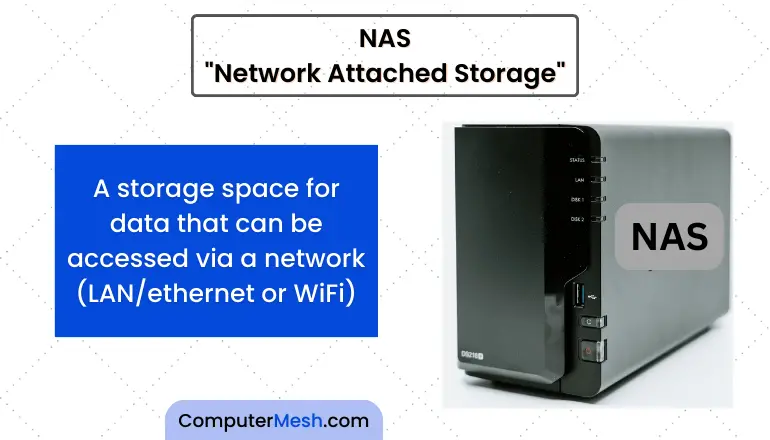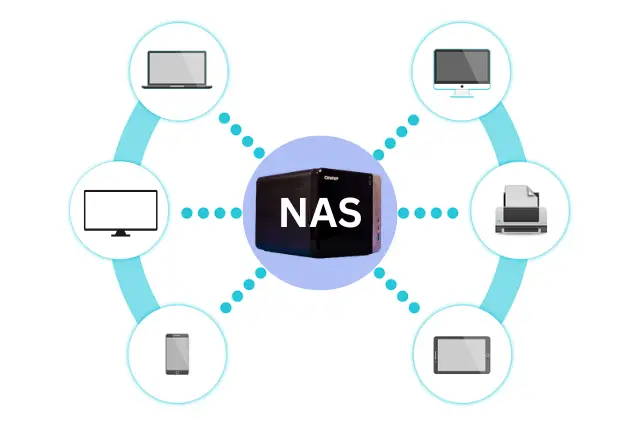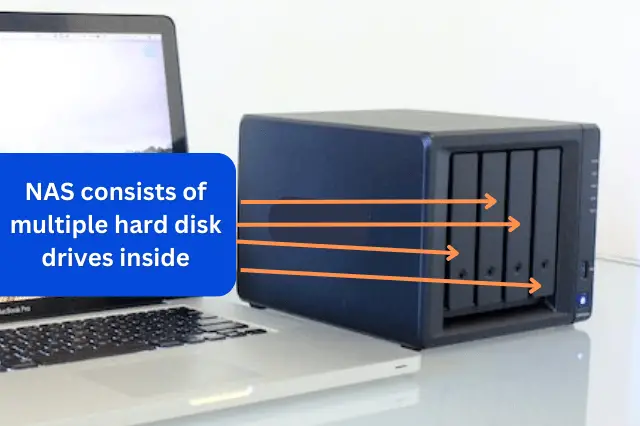What is NAS? How it is Different? Benefits & Disadvantages
In this article, I’ll explain What is NAS? How is it different from a normal hard drive? How NAS works? Benefits and Disadvantages of using NAS as storage. This guide will help you understand NAS thoroughly. Let’s read on.
What is a NAS?

NAS stands for “Network-Attached Storage,” also known as “network HDD” or “network hard disk.” It is simply a “storage space for data that can be accessed via a network” – LAN/ethernet or WiFi.
A NAS usually consists of a small dedicated computer with multiple hard disk drives inside. These drives are configured with a technology called RAID (Redundant Array of Independent Disks), which ensures data redundancy and protects data in the event of a failure.
It is a type of storage-oriented device with which you can create your own cloud storage at home. The difference with the clouds of other companies is that, in this case, the hard drives where your data is stored are in your home and not on the servers belonging to the company like Google Drive, Onedrive, Dropbox, etc.
And not only that, but some NAS also allows you to do other things like setting up web servers, VPNs, or even your own streaming service with the content you have on their hard drives as they are adapted to be running all day.
This is how NAS drives are designed to work around the clock in harsh environments. They can withstand a lot of vibration while running multiple drives simultaneously 24×7 hours in a compact box.
What is RAID in NAS?
RAID (Redundant Array of Independent Disks) is a technology used to improve storage systems’ performance and reliability, including NAS. It involves data protection by distributing data over multiple disks. If one disk fails, data can be automatically restored from other disks, thus making it easier to restore data even if it is damaged.
Different RAID levels offer varying combinations of these benefits, making them suitable for other use cases. Here’s a table explaining some standard RAID levels and their features:
| RAID type | Features | Robustness |
|---|---|---|
| RAID 0 | Data is stored in disks without redundancy (meaning if one drive fails, all data is lost) but high-speed processing and maximum capacity utilization. | None |
| RAID 1 | Data is mirrored onto a second drive, providing full redundancy. Read performance is good, but write performance is slower due to the need to write data to both drives. | Low |
| RAID 5 | A parity information is distributed across drives. This allows for recovery in case of a single drive failure. Read and write performance are decent, and it offers good storage efficiency. | Middle |
| RAID 6 | Similar to RAID 5 but with dual parity, allowing for recovery from the failure of up to two drives, provides better fault tolerance than RAID 5. | Middle |
| RAID 10 | Combines RAID0 and RAID1, offers excellent fault tolerance and good read and write performance, at the cost of reduced storage efficiency due to mirroring. | High |
How NAS is Different from Normal Hard Drive?
When thinking of computer storage, the first thing that comes to mind is probably the HDD. Well, HDDs and NAS are similar when reading and writing data on internal disks. The main difference lies in how they connect to a computer.
There are two types of HDDs: internal HDDs installed inside the computer and external HDDs connected via USB, SAS or SATA interfaces. Both require a direct, physical connection to your computer.

On the other hand, NAS is a “storage area that exists on the network,” as described above. Unlike HDDs, NAS doesn’t necessarily need a wired connection to a personal computer. Even with WiFi it can be integrated into the network as long as the router supports.
Below the table describing differences between external HDD and NAS:
NAS | External HDD | |
Connection method | Internet Network | Cable |
Installation location | Installed at the office and at home | Inside or Together with a PC |
Data sharing | Can be done with WiFi or Ethernet/LAN | WIth the USB or SATA Cable |
Users | Multiple | Personal |
Accessbility | PC, smartphone, tablet, TV, security, etc | Limited to Desktop and Laptop |
Set up | Initial setup required | Just connect with a USB cable |
Backup & Restore | Automatically if equipped with mirroring function | Manual |
Portability | No need to carry it around | Need to carry it around |
You do not have to confuse NAS with external hard drives. An external hard drive is just that, a storage unit that you plug and unplug, while the NAS works more like a network-connected computer that you can access from multiple devices and whose functionality you can extend.
Benefits of using NAS
The primary function of NAS is “storing data,” which is not different from HDD but at a large scale, like photo archives and music or video libraries. On average, NAS storage starts from 2TB. More benefits are worth highlighting:
1. Multiple devices can connect
External HDDs basically cannot be connected to multiple devices. It becomes necessary to unplug and plug the cable each time when using it as storage for multiple computers. Since NAS is made for use within a network, multiple devices can be connected to it.
You can easily copy, modify, and save files stored in the NAS, and all will get synchronized simultaneously so a user can access the latest version anytime via the network.
In other words, you can create an environment where anyone can easily access a single storage system at home or in the office using a hardwired LAN or wireless LAN. This is handy for teams who need to work on a project together or for students who need to stay up-to-date with their class materials.
2. Accessible from Smartphones, Tablets & Printer
If NAS is connected via Wi-Fi, it can be used as storage also for smartphones and tablets. It may be an excellent point for mobile devices with small storage capacity.

By connecting a USB printer to the USB port of the NAS, you can share the printer over the network. This method is recommended in environments where no printer can be used wirelessly.
3. As a Recorder
By connecting the TV recorder to the NAS via a router, the NAS can be used as storage for recording TV programs. Recorded programs can be viewed again on TV, in addition, you can watch recorded programs on any computer, smartphone, or tablet participating in the network.
Not only for TV but also by connecting multiple cameras to the NAS, you can easily manage surveillance camera footage, saving and viewing recorded footage on any device in the network.
This also makes it easy to access the footage remotely, making it an excellent choice for businesses and security with multiple locations.
4. Data Backup Automation and Restore
NAS is the best backup destination for important files, software, and database. A NAS on Wi-Fi does not require a wired connection, which makes it suitable for regular automatic backups.
You can restore the saved backup data when needed, which is especially useful for businesses and organizations that must ensure secure backup of critical data. It eliminates needing large pen drive sticks or external HDDs for games, data for backup options.
5. Remote access function
Many NAS implements a “remote access function” that allows you to access the data stored in your NAS from anywhere in the world. This function enables NAS to operate as cloud storage. You can easily access files and documents with colleagues or a media library with family members in different parts of the world.
Streaming music and videos over the internet is also possible, making it easier for you to enjoy content on any device at home or work.
6. Can Use a web server
Here is the possibility of hosting a server to upload a website using technologies such as PHP or SQL, so you can upload one that requires this service.
As a NAS, you will almost always have it on, the web will be operational next to it, and you will not have to spend money on third-party servers. As I said, NAS is made for constant 24 x 7 operation, something normal hard drives are incapable of.
Some NAS models have torrent clients, so you can use them to make available files that break large files into many small files to facilitate downloading in blocks. It comes to be like you can do it on your computer only by sending the downloads to the hard drives of the NAS, which, since it indeed has more storage than your PC, you can do many downloads.
7. Expandable Storage Capacity

NAS enables us to expand the existing storage capacity. A NAS is equipped with multiple hard disks, so storage capacity can be expanded as needed, giving you the freedom to grow your data archive without worrying about space restrictions. You can also add an external hard disk to some NAS models.
Disadvantages of NAS
1. Operation can be complicated
Some NAS models have complicated initial settings and setups and can be difficult to operate. Also, if administrators do not have the expertise, it can be challenging to troubleshoot any issues that arise.
2. Transfer speed depends on the network environment
Since NAS can be operated on both a wired LAN connection and wireless network, its transfer speed is affected by the network environment. If the internet environment is good, the transfer will get complete immediately when saving the data, but if it is bad, it may take tens of minutes. If you are worried about the internet environment, I recommend improving it in advance.
3. May have security issues

Since the NAS is connected to the network, it can be attacked from the web. There is a risk of data leakage and unauthorized access if proper security measures are not taken.
In other words, it is very convenient to use, but on the other hand, it is very different from other external HDDs, so it requires a certain amount of knowledge.
4. Risk of data loss due to hardware failure
Since NAS often consists of multiple hard disk drives, data can be protected even if one drive fails. In the event of its own failure, there is a risk of data loss.
Can you convert the External HDD into NAS?
It is also possible to convert a normal external HDD into a NAS. All you need is a router with a USB port and then configure it as a NAS device; you might need to install NAS software or an operating system that supports NAS features.
However, this will not provide the same features as a dedicated NAS device. For example, it will not have the same performance, security, or scalability. Additionally, you will be limited to the capabilities of the external HDD itself.
Which is better, NAS or Cloud Storage?
NAS and cloud storage have common features in data storage, multiple devices connection, good upload speed and downloading data anywhere as long as you have an internet connection. However, cloud storage can be used for free up to a certain amount, but you may be charged if you use it beyond that amount.
On the other hand, when considering operations, there is a big difference in management costs and expenses. Since NAS purchases hardware, it requires an installation location and regular maintenance. With cloud storage, you don’t have to pay for hardware management just by signing a service contract.
Regarding the cost per capacity, NAS is cheaper. Cloud storage requires monthly or yearly payment, and NAS has advantages for long-term storage as it costs money only for equipment purchase at first, but there is no monthly usage fee.
Cloud storage is safer than NAS when considering data loss due to physical accidents, etc. Depending on the service provider, cloud storage is equipped with disaster recovery, and a mechanism is built to prevent data loss in the event of a tragedy.
In addition, cloud storage stores and shares files on the Internet, so security vulnerabilities cannot be denied. However, NAS has a function that allows you to set advanced access privileges, etc., so the risk of data leakage is low.
In this way, NAS and cloud storage each have advantages and disadvantages. Consider using NAS and cloud storage properly according to the needs.
Wrapping Up
This time, I introduced the difference between HDD and NAS. In an environment with many devices accessing storage, using NAS has many benefits.
If everything you can do with one of these NAS has convinced you and you want to buy one, you will have to look at some features, from its processor and RAM to the number of bays it has, through its operating system or if Does it include hard drives or do you have to buy them separately?
NAS has various abilities that will improve the overall storage needs and durability. Of course, after all, overpricing is quite notorious, but you already know the saying that whoever wants something, something costs him.
FAQs
Does NAS have a built-in OS?
NAS software runs on an OS built into the hardware that supports network protocols such as FTP, SMB, and AFP for file sharing. Also, NAS that can be accessed via the Internet using TCP/IP and NAS with a dynamic virus detection function has appeared.
Is NAS calculated on 1024Byte = 1KByte?
NAS differs from Windows OS, and it doesn’t follow 1024Byte = 1KByte, but it is calculated as 1000Byte = 1KByte for storage.
What is RAID in storage disks?
RAID is an abbreviation for “Redundant Arrays of Inexpensive Disks” and is a technology that virtually builds multiple HDDs as a single HDD to improve redundancy. RAID reduces the risk of failure by distributing and writing data to multiple HDDs. A number is assigned to the end, and high-performance functions are given as the number increases.
Which hard disk drive is compatible with NAS?
The vast majority of NAS on the market are compatible with any hard drive on the market as long as its interface is SATA 3, but, indeed, the vast majority of them are also optimized in their firmware to be compatible with specific hard drives for NAS, thus taking advantage of its full potential.
